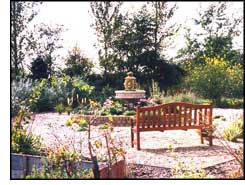
Main
Newsletter Deals
Forum - Outdoor Living
Product Reviews
Arbors
Barbecues and Grills
Bells and Chimes
Lanterns and Torches
Lighting
Outdoor Accents
Outdoor Furniture
Patio Decor
Planters
Feng Shui Tips
Feng Shui Garden
Garden Planning
Vegetable Gardens
Yard and Garden Care
Garden Ponds
Pool and Spa
Water Features
Water Fountains
Decks and Fences
Gazebos
Greenhouses
Shed and Storage
Patio Umbrellas
Birds and Birding
Bird Feeders
Bird Houses
Birdbaths
About ES
Site Map
Contact
Garden Planning
Using Your Garden Plan
Creating Your Design
|
When planning your garden there are guidelines that you may want to consider. 1. Never let an existing feature dictate your new garden unless you have no alternative but to work around it. For instance a large tree or an unsightly garage. Assess the area you are planning to use for your garden. Make a list of what has to stay and what you want to work around or improve. |
 |
2. Make a wish list before you begin your design. List what features you consider a priority or essential to your design.
3. After listing essentials, list elements that are desirable, however don’t cram so many in that your sense of strong design is lost.
4. It is a lot better and less expensive to make mistakes on paper first, rather than in the garden itself. Start by making a simple sketch of the garden as it is, and then work out your ideas.
We have included resources for your
garden project throughout the site.
Here are some tips if you are not used to drawing garden plans:
A. Draw the outline of the garden first, together with the position of the house and any other major features, and make sure you have the correct measurements for these before filling in any of the other elements.
B. Next, draw in those elements that re easy to position, such as rectangular flower beds, a circular pond or the garden shed, if you are reasonably sure of their position and know they will remain in your new design.
C. Ink in those elements of the garden that are fixed and will not change, such as boundaries and paths that you know you will not move. Draw the more movable garden features in pencil first, as it is quite likely that you may have to make slight adjustments before the plan is complete. Ink them in when you know everything is in its correct place.
D. Use a compass to draw curves and circles if possible. Not all curves are suitable for this, but you can buy flexible rulers that can be bent into any reasonable curve.
The exciting part of designing or redesigning a garden comes when the basic structure is on the drawing board and you can start to work magical transformations as you test your ideas. Drawing to scale is the next step to reach this goal.
The rough sketch must be transferred to a scale drawing before any detailed plans can be sketched out.
![]()
